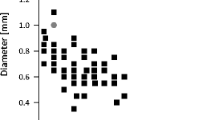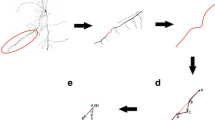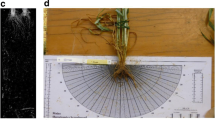Abstract
Root characteristics of seedlings of five different barley genotypes were analysed in 2D using gel chambers, and in 3D using soil sacs that were destructively harvested and pots of soil that were assessed non-invasively using X-ray microtomography. After 5 days, Chime produced the greatest number of root axes (∼6) and Mehola significantly less (∼4) in all growing methods. Total root length was longest in GSH01915 and shortest in Mehola for all methods, but both total length and average root diameter were significantly larger for plants grown in gel chambers than those grown in soil. The ranking of particular growth traits (root number, root angular spread) of plants grown in gel plates, soil sacs and X-ray pots was similar, but plants grown in the gel chambers had a different order of ranking for root length to the soil-grown plants. Analysis of angles in soil-grown plants showed that Tadmore had the most even spread of individual roots and Chime had a propensity for non-uniform distribution and root clumping. The roots of Mehola were less well spread than the barley cultivars supporting the suggestion that wild and landrace barleys tend to have a narrower angular spread than modern cultivars. The three dimensional analysis of root systems carried out in this study provides insights into the limitations of screening methods for root traits and useful data for modelling root architecture.






Similar content being viewed by others
References
Asseng S, Aylmore LAG, MacFall JS, Hopmans JW, Gregory PJ (2000) Computer-assisted tomography and magnetic resonance imaging. In: Smit AL, Bengough AG, Engels C, Van Noordwijk M, Pellerin S, van de Geijn SC (eds) Root methods. Springer, Berlin, pp 343–363
Basu P, Pal A, Lynch JP, Brown KM (2007) A novel image-analysis technique for kinematic study of growth and curvature. Plant Physiol 145:305–316. doi:10.1104/pp.107.103226
Bengough AG, Gordon DC, Al-Menaie H, Ellis RP, Allan D, Keith R et al (2004) Gel observation chamber for rapid screening of root traits in cereal seedlings. Plant Soil 262:63–70. doi:10.1023/B:PLSO.0000037029.82618.27
Bengough AG, Mackenzie CJ, Diggle AJ (1992) Relations between root length densities and root intersections with horizontal and vertical planes using root-growth modeling in 3-dimensions. Plant Soil 145:245–252. doi:10.1007/BF00010353
Bengough AG, Mullins CE (1990) Mechanical impedance to root-growth—a review of experimental techniques and root-growth responses. J Soil Sci 41:341–358
Clark LJ, Whalley WR, Leigh RA, Dexter AR, Barraclough PB (1999) Evaluation of agar and agarose gels for studying mechanical impedance in rice roots. Plant Soil 207:37–43. doi:10.1023/A:1004489501678
Dunbabin VM, Diggle AJ, Rengel Z (2002) Simulation of field data by a basic three-dimensional model of interactive root growth. Plant Soil 239:39–54. doi:10.1023/A:1014952728942
Forster BP, Thomas WTB, Chloupek O (2005) Genetic controls of barley root systems and their associations with plant performance. Asp Appl Biol 73:199–204
Futsaether C, Oxaal U (2002) A growth chamber for idealized studies of seedling root growth dynamics and structure. Plant Soil 246:221–230. doi:10.1023/A:1020609224525
Ge Z, Rubio G, Lynch JP (2000) The importance of root gravitropism for inter-root competition and phosphorus acquisition efficiency: results from a geometric simulation model. Plant Soil 218:159–171. doi:10.1023/A:1014987710937
Grando S, Ceccarelli S (1995) Seminal root morphology and coleoptile length in wild (Hordeum vulgare ssp. spontaneum) and cultivated (Hordeum vulgare ssp. vulgare) barley. Euphytica 86:73–80. doi:10.1007/BF00035941
Gregory PJ (2006) Plant roots: growth, activity and interaction with soils. Blackwell, Oxford, p 318
Gregory PJ, Hinsinger P (1999) New approaches to studying chemical and physical changes in the rhizosphere: an overview. Plant Soil 211:1–9. doi:10.1023/A:1004547401951
Gregory PJ, Hutchison DJ, Read DB, Jenneson PM, Gilboy WB, Morton EJ (2003) Non-invasive imaging of roots with high resolution X-ray micro-tomography. Plant Soil 255:351–359. doi:10.1023/A:1026179919689
Hargreaves CE (2006) Non-invasive three dimensional imaging of root-soil physical interactions. PhD thesis, School of Human and Environmental Sciences, University of Reading, Reading, UK
Jenneson PM, Gilboy WB, Morton EJ, Gregory PJ (2003) An X-ray micro-tomography system optimised for the low-dose study of living organisms. Appl Radiat Isot 58:177–181. doi:10.1016/S0969-8043(02)00310-X
Liao H, Rubio G, Yan XL, Cao AQ, Brown KM, Lynch JP (2001a) Effect of phosphorus availability on basal root shallowness in common bean. Plant Soil 232:69–79. doi:10.1023/A:1010381919003
Liao H, Yan XL (2001b) Genotypic variation in root morphological characteristics of common bean in relation to phosphorus efficiency. Acta Bot Sin 43:1161–1166
Lungley DR (1973) The growth of root systems—a numerical computer simulation model. Plant Soil 38:145–159. doi:10.1007/BF00011223
Lynch J, Brown KM (2001) Topsoil foraging—an architectural adaptation of plants to low phosphorus availability. Plant Soil 237:225–237. doi:10.1023/A:1013324727040
Lynch J, van Beem JJ (1993) Growth and architecture of seedling roots of common bean genotypes. Crop Sci 33:1253–1257
Manschadi AM, Christopher J, deVoil P, Hammer GL (2006) The role of root architectural traits in adaptation of wheat to water-limited environments. Funct Plant Biol 33:823–837. doi:10.1071/FP06055
Otten W, Hall D, Harris K, Ritz K, Young IM, Gilligan CA (2001) Soil physics, fungal epidemiology and the spread of Rhizoctonia solani. New Phytol 151:459–468. doi:10.1046/j.0028-646x.2001.00190.x
Pagès L (2002) Modeling root system architecture. In: Waisel Y, Eshel A, Kafkafi U (eds) Plant roots the hidden half, 3rd edn. Marcel Dekker, New York, pp 359–382
Pagès L, Aries F (1988) SARAH: a simulation model of the growth, development and architecture of root systems. Agronomie 8:889–896. doi:10.1051/agro:19881008
Pierret A, Doussan C, Garrigues E, McKirby J (2003) Observing plant roots in their environment: current imaging options and specific contribution of two-dimensional approaches. Agronomie 23:471–479. doi:10.1051/agro:2003019
Price AH, Steele KA, Moore BJ, Lones RGW (2002) Upland rice grown in soil-filled chambers and exposed to contrasting water-deficit regimes. II. Mapping quantitative trait loci for root morphology and distribution. Field Crops Res 76:25–43. doi:10.1016/S0378-4290(02)00010-2
Robinson D (1994) The responses of plants to non-uniform supplies of nutrients. New Phytol 127:635–674. doi:10.1111/j.1469-8137.1994.tb02969.x
Rubio G, Liao H, Yan XL, Lynch JP (2003) Topsoil foraging and its role in plant competitiveness for phosphorus in common bean. Crop Sci 43:598–607
van der Weele CM, Jiang HS, Palaniappan KK, Ivanov VB, Palaniappan K, Baskin TI (2003) A new algorithm for computational image analysis of deformable motion at high spatial and temporal resolution applied to root growth. Roughly uniform elongation in the meristem and also, after an abrupt acceleration, in the elongation zone. Plant Physiol 132:1138–1148. doi:10.1104/pp.103.021345
Wahbi A, Gregory PJ (1989) Genotypic differences in root and shoot growth of barley (Hordeum vulgare). 1. Glasshouse studies of young plants and effects of rooting medium. Exp Agric 25:375–387
Acknowledgements
CEH was supported by a research studentship from the Natural Environment Research Council of the UK. We wish to thank Drs Bill Thomas and Brian Forster for providing the barley lines and for helpful discussions, and Dr Derek Read for help with the X-ray equipment.
Author information
Authors and Affiliations
Corresponding author
Additional information
Responsible Editor: Jonathan P. Lynch.
Rights and permissions
About this article
Cite this article
Hargreaves, C.E., Gregory, P.J. & Bengough, A.G. Measuring root traits in barley (Hordeum vulgare ssp. vulgare and ssp. spontaneum) seedlings using gel chambers, soil sacs and X-ray microtomography. Plant Soil 316, 285–297 (2009). https://doi.org/10.1007/s11104-008-9780-4
Received:
Accepted:
Published:
Issue Date:
DOI: https://doi.org/10.1007/s11104-008-9780-4




